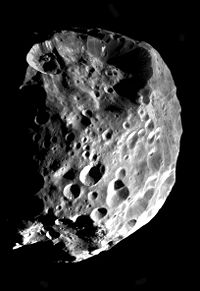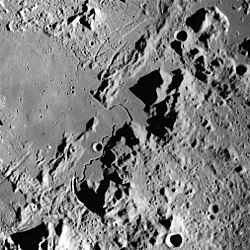Crater density

In astronomy and planetology, the crater density is the area-related number of impact craters on the surface of the earth's moon , an earth-like planet or a planetary moon . Their analysis gives indications of the formation of the craters, the age of the respective region and the temporal course of the causative impacts and the geological development.
Starting with the Voyager space probes into the outer solar system (1979–82), it was also possible to research the conditions on the large moons of Jupiter and Saturn . The most important finding from this is the direct relationship between the crater density and the age of the surface. The moons with the most craters (e.g. Callisto ) usually have the oldest surface because they have hardly been changed by erosion or lava flows since the Great Bombardment about 4 billion years ago.
overview
Different crater densities of celestial bodies or local differences on their surfaces allow not only the age determination but also the estimation of soil parameters of the respective celestial body, for example the rock strength, the content of ice, the erosion or the sliding behavior of the rubble.
It was only in the 1970s that interplanetary space probes were able to demonstrate that Mercury , Mars and the large moons of Jupiter have numerous craters in addition to the moon . The view, which is quite similar to the moon craters, shows larger differences in detail, for example in the size distribution, in the ratio of diameter to depth and in weathering . The latter two parameters depend mainly on the gravitational field and , to a lesser extent, on the air density and the nature of the soil. The age of many geological structures can be derived from regionally different crater densities. The falling objects also turned out to be different and gave clues to the early history of the solar system . Small and larger asteroids predominated up to the orbit of Mars, and early cometary nuclei from the orbit of Jupiter .
Analysis of the lunar craters
The exploration of the craters began - apart from the earth's volcanoes - naturally on the earth's moon . The fact that other moons or terrestrial planets also have craters was only proven by space probes from the 1960s .
The first telescope observations from 1610 already showed that the southern hemisphere of the moon has many more craters than the northern hemisphere, on which the relatively smooth lunar seas (mare) dominate. It was soon discovered that
- the number of craters increases sharply (roughly square) with decreasing size
- all craters are approximately round,
- their floors are lower than the surroundings, and
- the smaller the diameter, the steeper the crater walls .
The larger structures (from about 60 km) were called ring mountains because of the shape of their wall , the very large ones with a smooth bottom were called whale plains ; some of them reach 300 km or almost 10% of the diameter of the moon.
First accurate study of lunar craters took especially Hieronymus Schröter ago (1800). In addition to their size distribution, he also analyzed the inclinations of the crater walls, the weathering or destruction by subsequent impacts, as well as relationships to lunar grooves and the formation of the lava covers of lunar seas .
The crater density of individual lunar regions varies greatly, especially between the "old", bright highlands and the younger Maren, covered with dark lava and basalt blankets. The latter show significantly fewer craters and mostly only smaller ones. This was correctly interpreted as a result of the basalt floods and a decrease in the frequency of impacts from space over the course of millions of years. Radiometric age dating of lunar samples from the Apollo and Luna missions revealed an age of around 4 billion years for the highland rocks, while the basalt plains are noticeably younger. In the highlands, the crater density is 0.36 per km² (for craters over 1 km in diameter). Diagrams were created from all data and the crater density was shown as a function of time. In this way, the time of the most violent impacts (“ large bombardment ”) could be narrowed down more precisely - to the period 4.1 to 3.8 billion years ago.
After that, the rate of crater formation fell to less than a hundredth and has remained almost stable at a low level since then. The same applies to the other earth-like heavenly bodies.
Crater density on other celestial bodies
On the rocky planets in the inner solar system , as on the moon, most of the craters were created by impacts by asteroids of various sizes, most of which occurred during the " Great Bombardment " around 4 billion years ago. In the case of larger bodies, fragments that were blasted off often created secondary craters in the vicinity. The crater diameters are around 15 to 20 times larger than the impacting bodies. Some chains of craters (e.g. on Mars - which, however, has only a few cratered areas - and on Jupiter's moon Ganymede) indicate that the impactor burst just before the impact.
The current rate of crater formation is hundreds to a thousand times lower. Younger craters are often recognizable by their bright ejecta, which can form a system of rays .
On the large moons in the outer solar system , comet nuclei were the main cause of crater formation, whereas asteroids only make up a few percent. The crater density depends strongly on the rock material of the moon, in particular on its strength and the content of ice . Almost the same formation rate is assumed on all moons, but with loose rock the craters are shallower and erode much faster. Two extremes can be found under the 4 large moons of Jupiter :
- The innermost moon Io does not show any craters because its surface is constantly "tumbled through" by strong tidal forces. The heat and the current volcanism also promote the erosion of any impact structures.
- Jupiter's outer moon Callisto , on the other hand, is "saturated" at craters - i.e. H. each newly formed crater destroys an older one on average.

The 220 km large Saturn moon Phöbe is the most heavily cratered celestial body in the solar system , as image data from space probes showed. The crater density is an indicator of the age of a moon's surface; NASA gives Phöbe 4.5 billion years old - almost as old as the sun itself. The moon has probably hardly changed since then.
The planet Mercury also has a high density of craters - probably because of the extremely thin atmosphere, which allows small bodies to penetrate unhindered.
The distribution of Mercury's craters varies less than on the Moon or Mars, which indicates that the surface is equally old. However, there are also areas with fewer craters, which have been called "intermediate levels". The age of the rock crust (since it was solidified) is estimated to be 4 to 4.5 billion years. Similar to the moon, recent impacts have created some large systems of rays .
Venus has far fewer craters : on the one hand because the extremely dense atmosphere only allows larger bodies to penetrate, on the other hand because the aggressive erosion quickly levels the craters. Even on Earth, a 20 km crater like the Nördlinger Ries would have disappeared in no more than 500 million years.
The crater density on Mars, in turn, varies greatly, depending on the age of the terrain formation. Some regions are comparable to the moon, but tectonically younger regions are almost free of craters.
Ganymede (Jupiter), Saturn's moons and most asteroids have a medium crater density - as far as this can be proven from space probe photos.
Literature and web links
- Patrick Moore et al .: Atlas of the solar system (especially chapter of the individual celestial bodies). 465 pp., Herder-Verlag Freiburg-Basel-Wien, approx. 1990
- J. Kelly Beatty et al .: The sun and its planets (especially chapter 4, collision of solid bodies ). Physik-Verlag, Weinheim 1981
- Antonín Rükl : Moon, Mars, Venus. Pocket atlas of the closest celestial bodies . Artaria Publishing House, Prague 1977
- Heather Couper , Robert Dinwiddie et al .: The Planets. A journey through our solar system. Publisher Dorling Kindersley, Munich 2015
- Further references and web links will follow with later additions.

